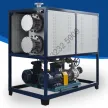Jan. 18, 2024
Machinery
Steam boilers play a crucial role in various industrial and commercial applications, providing a reliable source of energy for processes such as heating, power generation, and manufacturing. These boilers come in different types, each designed to cater to specific needs and operational requirements. In this article, we will delve into the world of steam boilers, exploring the various types available and their unique characteristics.
Fire-Tube Boilers:
One of the oldest and most common types of steam boilers is the fire-tube boiler. In this design, hot gases from combustion pass through tubes submerged in water, generating steam. Fire-tube boilers are known for their simplicity and ease of maintenance. They find applications in small to medium-scale industries where moderate steam production is required.
Water-Tube Boilers:
In contrast to fire-tube boilers, water-tube boilers have water-filled tubes that circulate through a furnace. These boilers are favored for their ability to handle higher pressures and temperatures, making them suitable for power generation and large industrial processes. Water-tube boilers are known for their efficiency and versatility.

Electric Boilers:
Electric boilers are gaining popularity due to their clean and efficient operation. They use electricity to generate steam, eliminating the need for traditional fuels. Electric boilers are often chosen for their environmental friendliness, ease of installation, and precise control over steam production. They are commonly employed in facilities where emissions and fuel storage are concerns.
Package Boilers:
Package boilers are factory-assembled and delivered as complete units, ready for installation. These boilers are compact and cost-effective, making them ideal for smaller applications or industries with space constraints. Package boilers come in various designs, including fire-tube, water-tube, and electric, offering flexibility to meet different requirements.
Coil Type Boilers:
Coil type boilers, also known as once-through boilers, operate by passing water through a coil of pipes where it absorbs heat and turns into steam. These boilers are known for their quick response to load changes and high efficiency. Coil type boilers are commonly used in industries requiring rapid steam generation and precise temperature control.
Biomass Boilers:
With a growing emphasis on sustainable energy sources, biomass boilers have gained prominence. These boilers use organic materials such as wood, agricultural residues, or municipal solid waste to generate steam. Biomass boilers contribute to reducing carbon footprints and are commonly used in industries aiming for eco-friendly and renewable energy solutions.
Condensing Boilers:
Condensing boilers maximize energy efficiency by recovering heat from the flue gases that would otherwise be wasted in traditional boilers. These boilers are known for their ability to operate at high efficiency levels, making them an attractive choice for environmentally conscious industries. Condensing boilers are often used in heating applications where fuel efficiency is crucial.
Conclusion:
In conclusion, the world of steam boilers is diverse, offering a range of options to cater to the unique needs of various industries. From traditional fire-tube and water-tube boilers to modern electric and condensing boilers, each type has its advantages and applications. The choice of a steam boiler depends on factors such as the scale of operation, energy source preferences, and environmental considerations. As technology continues to advance, the steam boiler industry evolves, providing innovative solutions for efficient and sustainable steam generation.
If you are interested in sending in a Guest Blogger Submission,welcome to write for us!
All Comments ( 0 )